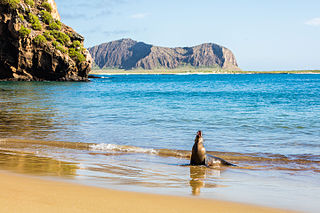
The Galápagos Islands are an archipelago of volcanic islands in the Eastern Pacific, located around the Equator 900 km (560 mi) west of South America. They form the Galápagos Province of the Republic of Ecuador, with a population of slightly over 33,000 (2020). The province is divided into the cantons of San Cristóbal, Santa Cruz, and Isabela, the three most populated islands in the chain. The Galápagos are famous for their large number of endemic species, which were studied by Charles Darwin in the 1830s and inspired his theory of evolution by means of natural selection. All of these islands are protected as part of Ecuador's Galápagos National Park and Marine Reserve.

Galápagos (1985) is the eleventh novel published by American author Kurt Vonnegut. Set in the Galápagos Islands after a global financial disaster, the novel questions the merit of the human brain from an evolutionary perspective. The title is both a reference to the islands on which part of the story plays out, and a tribute to Charles Darwin, on whose theory Vonnegut relies to reach his own conclusions. It was published by Delacorte Press.

Rábida or Rabida Island is one of the Galápagos Islands. It is 5 km2 (1.9 sq mi) in area.
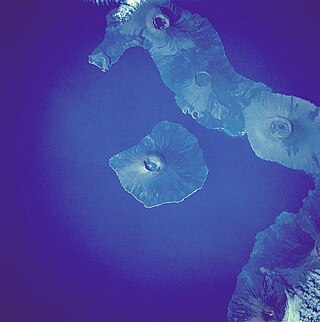
Fernandina Island is the youngest and third largest island in the Galapagos, as well as the furthest west. It has an area of 642 km2 (248 sq mi) and a height of 1,476 m (4,843 ft), with a summit caldera about 6.5 km (4.0 mi) wide. It is younger than Isabela, being only less than one million years old since its formation. Like the other islands, it was formed by the Galápagos hotspot. The island is an active shield volcano that has most recently erupted in January 2020.

San Cristóbal Island, also known as Chatham Island, is the easternmost island in the Galápagos archipelago, as well as one of the oldest geologically. It is administratively part of San Cristóbal Canton, Ecuador.

Daphne Major is a volcanic island just north of Santa Cruz Island and just west of the Baltra Airport in the Archipelago of Colón, commonly known as the Galápagos Islands. It consists of a tuff crater, devoid of trees, whose rim rises 120 m (394 ft) above the sea.
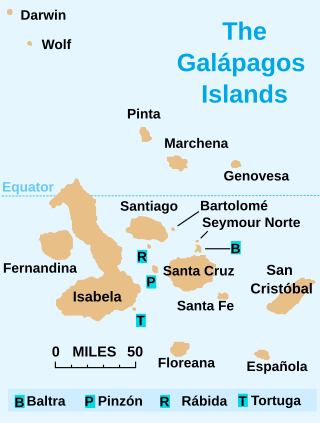
Isabela Island is the largest of the Galápagos Islands, with an area of 4,586 km2 (1,771 sq mi) and a length of 100 km (62 mi). By itself, it is larger than all the other islands in the chain combined and it has a little under 2000 permanent inhabitants. The island straddles the equator.

Santa Cruz Island, also known as Indefatigable Island and by other names, is the most populous and second-largest island in the Galápagos Islands, Ecuador. Situated in the middle of the group, Santa Cruz is a shield volcano with an area of 986 km2 (381 sq mi) and a maximum altitude of 864 m (2,835 ft). The seat of Santa Cruz Canton is Puerto Ayora on Santa Cruz. The island's total population is around 18,000 with those living in smaller villages chiefly working in agriculture and cattle raising.

Floreana Island is a southern island in Ecuador's Galápagos Archipelago. The island has an area of 173 km2 (67 sq mi). It was formed by volcanic eruption. The island's highest point is Cerro Pajas at 640 m (2,100 ft), which is also the highest point of the volcano like most of the smaller islands of Galápagos. The island has a population of about 100.

Baltra Island is a small island in the Galápagos Archipelago in Ecuador. It is a small flat island located near the center of the chain and includes Seymour Airport (GPS), originally established by the United States Air Force to help monitor and protect western access to the Panama Canal. Baltra is not part of the Galápagos National Park but some effort has been made to protect the local environment, including modernization of the airport and the reintroduction of the island's land iguanas.

Genovesa Island, also known as Tower Island, is a shield volcano in the Galápagos Islands in the eastern Pacific Ocean. The island occupies about 14 km2 (5 sq mi), and its maximum elevation is 64 m (210 ft). The horse-shoe shaped island has a volcanic caldera whose wall has collapsed, forming the Great Darwin Bay, surrounded by cliffs. The saltwater Lake Arcturus lies in the middle, and sediment within this crater lake is less than 6,000 years old. Although no historical eruptions are known from Genovesa, there are very young lava flows on the flanks of the volcano.

Española or Espanola Island is the most southerly of the Galápagos Islands in Ecuador, about a 10 to 12-hour trip by boat from Santa Cruz.
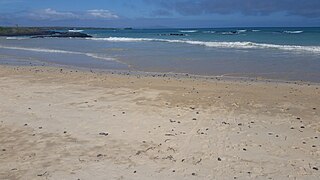
Santa Fe Island, also known as Barrington Island, is a small island of 24 square kilometres (9.3 sq mi) which lies in the middle of the Galápagos Archipelago in Ecuador. Visitor access is by a wet landing in Barrington Bay on the northeastern side of the island.

San Cristóbal Canton is a canton of Ecuador in the Galápagos Islands archipelago and one of the oldest in this insular geological formation. It consists of Española, Floreana, Genovesa, San Cristóbal, and Santa Fe Islands.
Pinta Island is one of the Galápagos Islands in Ecuador, west of South America. Pinta has an area of 60 km2 (23 sq mi) and a maximum altitude of 777 meters (2,549 ft).

South Plaza is a small island off the east coast of Santa Cruz in the Galápagos Islands. It has an area of 0.13 km2 and a maximum altitude of 23 metres.
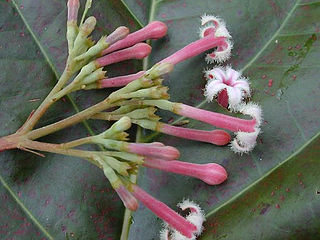
Cinchona pubescens, also known as red cinchona and quina (Kina), is native to Central and South America. It is known as a medicinal plant for its bark's high quinine content- and has similar uses to C. officinalis in the production of quinine, most famously used for treatment of malaria.

Guy Fawkes Island, properly the Guy Fawkes Islands, is an island group composed of two crescent-shaped islets—North Guy Fawkes I. and South Guy Fawkes I. —and two rocks located northwest of Santa Cruz Island in the Galápagos Archipelago in Ecuador. The group is uninhabited but sometimes visited by scuba divers.
Nameless Island is an islet of the Galápagos Islands group, in Ecuador, between Pinzón Island and Santa Cruz Island (Galápagos). The island is most commonly used for scuba diving.
















